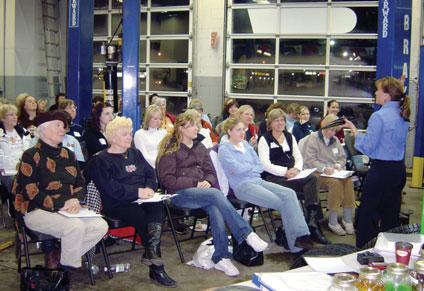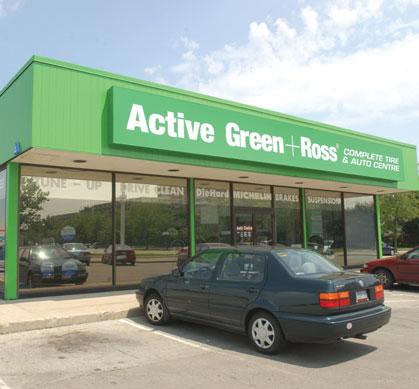
8 minute read
No snow needed to sell winter tires

from Modern Tire Dealer - March 2012
by EndeavorBusinessMedia-VehicleRepairGroup
to sell No snow needed
Educate consumers on safety to bring in winter tire sales and additional profi t centers
By Bob Bissler
Weather alert: Th e United States is experiencing a mild winter with less snow. But that doesn’t mean winter tire sales should suff er.
In areas of the country that experience cold temperatures, there is still a market for winter tires even without major snowfall. And when you can sell winter tires, you can sell other services along with them such as tire storage and a second set of wheels.
Th e Canadian perspective
Winter tire sales are a three-season project. You order them in the spring so you can get them in the fall for use in the winter.
In Canada, the winter tire market represents a greater percentage of the total market than it does in the U.S. It also is defi ned diff erently. According the Rubber Association of Canada (RA C), winter tire shipments in 2011 totaled 7 million units, down 1.2% compared to 2010. Th ey still accounted for nearly 38% of total replacement passenger and light truck tire shipments.
In the U.S., winter tire shipments were up. According to the Rubber Manufacturers Association (RMA), passenger tires with traction and snow traction treads totaled 9.5 million units, up 9.2% compared to the previous year. However, they represent less than 5% of total replacement passenger tire shipments. (Th e RMA does not include light truck tires in its winter tire statistics.)
Canada generally gets more snow than the U.S. Canada also is experiencing a winter with less snow than usual, but in certain parts of the country, that means only two feet of snow instead of six.
winter tires

Also, winter tires are mandatory in the Canadian province of Quebec. From Dec. 15 through March 15, all passenger cars and light trucks are required to drive on them.
Normand Latremouille, Canadian winter tire segment manager for Michelin North America Inc., says tire dealers outside of Quebec could sell more winter tires, regardless of the amount of snowfall.
“In other provinces it’s a diff erent story. If we look at Canada’s biggest population area, which is Toronto and south Ontario, many people say their all-seasons are OK. Dealers must say to them, ‘No, you need winter tires in the Canadian winter because of the cold. It’s more for the cold than for the snow that we have.’”
If consumers are taught that the compound of an all-season tire starts to harden at 45 degrees Fahrenheit (7 degrees Celsius), they will be more likely to consider winter tires (see “Th e pencil principle” sidebar on page 27).
“What keeps your tire going on the road is fl exibility,” says Latremouille. “Winter tires are made with a more fl exible compound that can resist the colder temperatures.”
While the U.S. may have less snow than usual, there are still many areas with temperatures well below 45 degrees F. According to the National Oceanic and Atmospheric Administration, the average contiguous U.S. temperature in January 2012 was 36.3 degrees F. Th at’s 5.5 degrees F above the 1901-2000 long-term average, and the fourth warmest January on record. But it’s still cold enough to make winter tires a necessity.
Professional race car driver Kelly Williams conducts a Car Care Clinic at an Active Green + Ross tire center in Toronto, Ontario. The 75-store chain conducts the clinics as part of its corporate policy of community awareness.
“Within Canada and the U.S., our message is make sure you’re equipped properly for the environment you’re in,” says Ron Margadonna, Michelin’s senior technical marketing manager. “If you’re in a fairly moderate to severe winter climate, you really need winter tires.
“Your all-season tire is just not going to cut it in those severe conditions. Winter tires are equipped not only to grip snow, ice and slush, but there’s also the temperature aspect.”
Black ice
“We keep repeating the safety aspect of winter tires,” says Andy Chiodo, marketing manager at Active Green + Ross, an Ontariobased chain of 75 tire and auto centers. “When customers come in for tire replacements in the fall, we say, ‘Here are the winter tires that we recommend for your car.’ If they say they don’t need winter tires, we ask if they’ve ever experienced black ice.
“You never know what the ground temperature is in the morning. Th e safety part of it is the big sell.”
To help spread the word, Active Green + Ross conducts car care clinics throughout the year.
“We have a lady’s clinic that has been so well-received, men want to come,” says Chiodo. “We have a professional race car driver named Kelly Williams who does them for the women for us. Th at’s part of the community awareness on tires.”
He says the clinics are promoted through newspaper announcements, posters and fl yers. Th e free clinics usually get from 30 to 40 people who come to the two-hour evening events.
“We’ll go over car maintenance, tire pressures and the difference between winter tires and all-season tires,” says Chiodo. “It’s strictly for consumer education; we’re not selling them anything. Hopefully by educating them, they will come and bring us business. We give them a tire pressure gauge with our name and number, and we show them how to check their tires.”
Another way to promote the sale of winter tires during the fall and spring changeover seasons is to use point-of-sale materials from manufacturers. Chiodo does this, and also recommends posting an informative article on your website, in a regional magazine or a local newspaper.
The RMA and the RAC both provide posters and pamphlets that can be handed out to consumers. “It’s information from an independent agency saying you’re bett er off with winter tires,” says Margadonna.

Active Green + Ross brings winter tire customers back in the spring by offering free winter tire changeovers. Shown is the Guelph-Burlington facility of the Ontario-based, 75-store chain.

“Th e Rubber Association of Canada sends out posters saying that winter tires should be equipped in sets of four,” says Chiodo.” Th ere’s the 7 degrees C poster, too. We use that as a selling point. Once the temperature drops down to 7 degrees C or lower, it’s not safe to have all-seasons. (It’s) mid-October when we start talking about that.”
Store at your store
An additional profi t center related to winter tire sales is the service of winter and summer tire storage.
The pencil principle Want to easily illustrate to your customers the difference between winter tires and all-season tires? Keep pencils in your break room’s freezer.
First show your customer the fl exibility of a room-temperature pencil eraser. Then let them feel how hard the frozen rubber eraser becomes thanks to the cold temperature.
It’s an easy way to illustrate an important safety issue.
“Some of our locations will store them on site and some will use an outside storage company that will pick them up, store them for us and bring them back,” Chiodo explains. “Tire storage is becoming more and more popular, especially downtown where people don’t have the space to store them. It’s the convenience factor.”
Active Green + Ross charges anywhere from $60 to $100 to store a customer’s winter tires. If a customer stores their tires, the company will switch them over for free in the spring and fall.
Th is additional service actually does more than simply bring in extra business. It also gets the customer back into your shop.
“Any time you can get a consumer in your business twice a year, fall and spring, that’s a good thing, particularly if you’re in business beyond tires such as mechanical work,” says Margadonna. “But from the tire perspective and the safety perspective, that means that those tires are being inspected at least twice a year by trained professionals. For tire dealers that is a huge benefi t and opportunity.”
Tire dealers have had help spreading
the word on winter tire safety in recent years. Manufacturers, associations and the media also have placed greater emphasis on consumer education. “The media does a good job of educating consumers,” says Chiodo. “As soon as we have the fi rst snowfall, you’ll see on the TV news and in the newspapers stories on making sure you get winter tires, and also An additional profi t center for that all-seasons don’t dealers is selling a second set of perform. Media is a big wheels for winter tires. They pay for themselves by eliminating mounting and balancing charges. part of it. “We get involved, too. Aft er the fi rst snowfall, people from the media will show up at our stores and report on all the last-minute people coming out and gett ing their winter tires.”
Th e result is that many consumers who come into your shop are already educated, says Nelson Tonn, vice president, marketing and supply chain for Fountain Tire Canada, a 140-store chain. ■
Tire changeover snowballs into added wheel sales
With winter tire sales comes the opportunity to sell a second set of wheels. The winter tires are mounted and balanced on their own wheels, so changing them over is less expensive because they are already mounted and balanced.
“Our selling feature on a second set of wheels is, if we sell them to you, we won’t charge to change them over in the spring and fall,” says Andy Chiodo, marketing manager at Active Green + Ross, in Ontario, Canada.
When customers come in for tire replacements in the fall and spring, here’s what Chiodo tells them.
“When you switch them over each year, it becomes more costly than buying a separate set of steel wheels. The cost is anywhere from $60 to $100 for a set of four, and if you multiply that over four years, there’s (the price of) your steel wheels. The cost of a steel wheel is anywhere from $69 to $79.
“It pays for itself in the long run, and you’re protecting your aluminum OE wheels so they don’t get damaged from sliding or from the salt they use on the roads.’”




